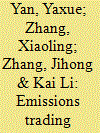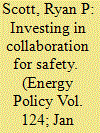| Srl | Item |
| 1 |
ID:
171482


|
|
|
|
|
| Summary/Abstract |
The study aims to employ the difference-in-differences method and mediating effect model to assess panel data of 267 prefectural-level cities in Chinese 30 provinces from 2003 to 2016 and empirically examines whether the Emissions Trading System pilot has realized collaborative governance effects upon air pollution. This study verifies the rationality of the element design of China's Emissions Trading System pilot from the perspective of environmental effects. The results indicate that the China's Emissions Trading System pilot does have a significant ‘reduction effect’ on haze pollution concentration level, which is probably achieved by ‘boosting the application and transformation of green technologies among enterprises’ and ‘transferring heavily polluted industries’. Moreover, the total quota allocation, total number of incorporated enterprises and the entry of institutional and individual investors were not the significant influencing factors for reducing haze pollution, while the transaction volume of China Certified Emission Reduction and the total penalty amounts incurred play significant roles. The heterogeneity test shows that only Guangdong province's policy has a significantly negative effect on haze pollution concentration. This study provides a new way of thinking for the coordinated governance mode by combining environmental governance and carbon trading scheme. The experiential evidence strongly supports the establishment and improvement of China's Emissions Trading System pilots and the implementation of a unified national carbon market.
|
|
|
|
|
|
|
|
|
|
|
|
|
|
|
|
| 2 |
ID:
162891


|
|
|
|
|
| Summary/Abstract |
Oil and gas pipeline leaks are the responsibility of a wide range of stakeholders including utilities, the public, construction firms and state safety program personnel. As a result, in the United State, state pipeline safety programs focus heavily on public education, outreach, and stakeholder participation so as to reduce the occurrence of these events. The US Pipeline & Hazardous Materials Safety Administration (PHMSA) directs federal support to state safety efforts through formula and project grant programs for state and local agencies that emphasize different aspects of collaboration. We combine these grant data with nationwide, longitudinal records on pipeline leaks, and use a multilevel Bayesian model to evaluate how different grant emphases relate to subsequent incident rates. State damage prevention grants are not associated with reductions in leaks but are associated with improvements in error recognition. Pipeline incidents are downstream from safety programs and impacts and identifying, minimizing, and correcting leaks requires states to motivate utility actions while also attempting to improve public awareness. This makes assessment of safety outcomes a challenge without better tracking of safety program communications and participation. In conclusion, we suggest improvements to data provision by states that could provide improved evidence for assessing safety improvements.
|
|
|
|
|
|
|
|
|
|
|
|
|
|
|
|